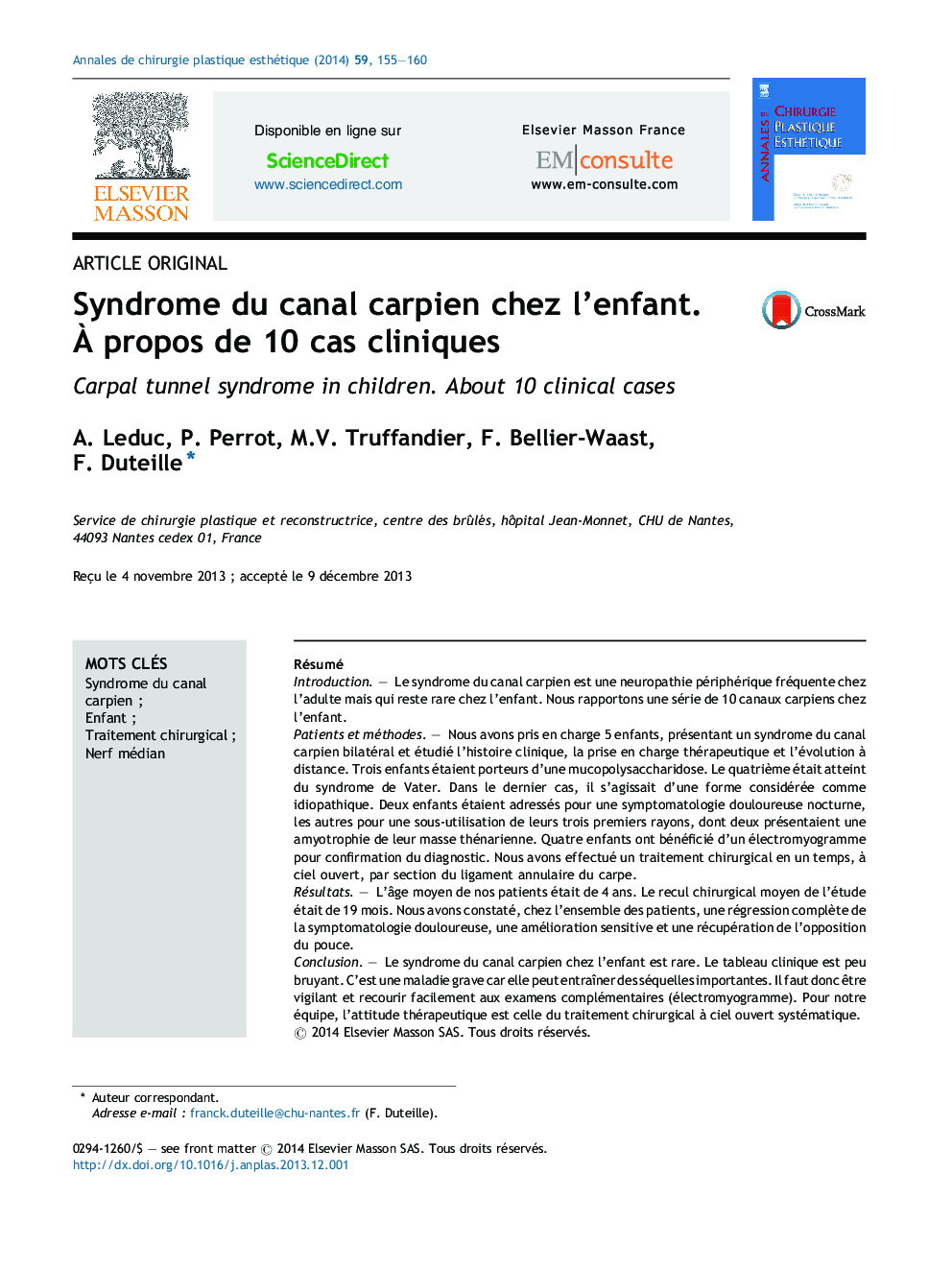| Article ID | Journal | Published Year | Pages | File Type |
|---|---|---|---|---|
| 3184597 | Annales de Chirurgie Plastique Esthétique | 2014 | 6 Pages |
RésuméIntroductionLe syndrome du canal carpien est une neuropathie périphérique fréquente chez l’adulte mais qui reste rare chez l’enfant. Nous rapportons une série de 10 canaux carpiens chez l’enfant.Patients et méthodesNous avons pris en charge 5 enfants, présentant un syndrome du canal carpien bilatéral et étudié l’histoire clinique, la prise en charge thérapeutique et l’évolution à distance. Trois enfants étaient porteurs d’une mucopolysaccharidose. Le quatrième était atteint du syndrome de Vater. Dans le dernier cas, il s’agissait d’une forme considérée comme idiopathique. Deux enfants étaient adressés pour une symptomatologie douloureuse nocturne, les autres pour une sous-utilisation de leurs trois premiers rayons, dont deux présentaient une amyotrophie de leur masse thénarienne. Quatre enfants ont bénéficié d’un électromyogramme pour confirmation du diagnostic. Nous avons effectué un traitement chirurgical en un temps, à ciel ouvert, par section du ligament annulaire du carpe.RésultatsL’âge moyen de nos patients était de 4 ans. Le recul chirurgical moyen de l’étude était de 19 mois. Nous avons constaté, chez l’ensemble des patients, une régression complète de la symptomatologie douloureuse, une amélioration sensitive et une récupération de l’opposition du pouce.ConclusionLe syndrome du canal carpien chez l’enfant est rare. Le tableau clinique est peu bruyant. C’est une maladie grave car elle peut entraîner des séquelles importantes. Il faut donc être vigilant et recourir facilement aux examens complémentaires (électromyogramme). Pour notre équipe, l’attitude thérapeutique est celle du traitement chirurgical à ciel ouvert systématique.
SummaryIntroductionThe carpal tunnel syndrome is a common peripheral neuropathy in adults but is rare in children. We report a series of 10 carpal tunnel syndromes in children.MethodsWe have supported five children, two males and three females, with a bilateral carpal tunnel syndrome. We studied the clinical history (history, symptoms, stage of disease), therapeutic management and remote development. Three children were diagnosed with a mucopolysaccharidosis, the fourth with VATER association. For the last child, it was a form considered idiopathic. Two children were referred for night pains, the others for under-utilization of their first three fingers, two of which had a thenar atrophy. Four children underwent an electromyogram for diagnostic confirmation. We realized open surgical treatment at one time, by section of the carpal ligament.ResultsThe average age of our patients was 4 years. The average decline in the surgical study was 19 months. Postoperatively, we noted, in all patients, complete regression of the painful symptoms, a sensory improvement and recovery of the opposition of the thumb.ConclusionThe scarcity of carpal tunnel syndrome in children and the atypical symptoms may cause diagnostic delay, with serious consequences. We keep vigilant and ready to access to additional tests (electromyogram). For our team, the therapeutic approach is a systematic open surgical treatment.
